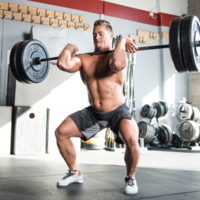How to create a training program to attack your weak areas and continue making strength gains with Hall of Fame Powerlifter Brad Gillingham.
Mixing up your training by periodically incorporating different methods not only keeps things interesting, but helps to strengthen weak areas. I have written a lot about the power rack partial training (PRT) that my father Gale Gillingham utilized throughout his Green Bay Packer Hall of Fame career. This past year, through the process of rehabbing a bad back, I came up with a different PRT-Hybrid method of combining full squats (FS) and PRT squats in the same workout.
The long Minnesota winter of 2018-2019 was disaster for my back. Heavy training, record snowfall, and being over 50 was not a great combination. It’s tough to describe a bad Minnesota winter unless you have experienced it. Last January I was training for the Arnold; everything was going well and I had my sights set on an 800 lb. raw deadlift. Unfortunately, my back began to tighten as the winter wore on. By the time the Arnold came around I was in bad shape, and my back continued to get worse into April. Eventually I had to take six weeks off from any squatting and deadlifting, and was forced to drop out of the IPF World Championships.
In mid-May, I started a plan to rehab my back by working on range of motion with very light back squat (BS) singles. Each single was immediately followed by a PRT single. I didn’t know it then, but this was the beginning of a new PRT-Hybrid method to my traditional PRT training. PRT-Hybrid was developed over time with each workout different from the next.
Post-Activation Potentiation Principles
As my back began to heal, the training loads were increased. My PRT-Hybrid workouts were eventually organized into the current method of sets and intensity guidelines that I follow each workout. The workout basically follows principles of Post-Activation Potentiation (PAP). PAP works on the concept that contracting muscle with a heavier load (conditioning exercise) will produce a greater rate of force development post-movement. PAP is generally incorporated into complexes that utilize a heavy movement, like squatting, as a conditioning exercise that is followed, after a designated rest period, by an explosive plyometric exercise. I have incorporated the PAP method on a frequent basis when programming training of plyometric complexes when coaching the volleyball team. I’ve used a variation of PAP in my bench training for several years by performing a heavy single as a conditioning exercise prior to my work sets, and found that the work sets generally feel lighter and move faster with this method.

The Hybrid-PRT Method
My current Hybrid-PRT design incorporates six sets of two, alternating BS singles with PRT singles, for a total of twelve repetitions. Most weeks I include a light and heavy workout. On my light day, I keep my BS singles in the 60%-70% range, and the PRT singles in the 75%-85 % range. An example of load intensity based on a 600 lb. BS and a 1000 lb. PRT squat would be 360-420 lb. BS/750-800 lb. PRT. On my heavier day I perform the six sets of two with a progressive BS load ranging from 60%-80%, and a progressive PRT load above 80%. The progressive linear range on the PRT squat may be 80%-100 %+ over 4 -6 weeks. At this point, I typically increase or decrease the PRT rack height. After warm-up, I complete my first BS single and then immediately complete my PRT single. I take a two-minute rest period, and then I complete my second BS single immediately followed by my PRT single. I repeat this method until all six sets are completed. This is where PAP comes into play. The BS singles feel very light and explosive following the heavier PRT conditioning load.
Utilizing this method has my back feeling stronger and I have continued to train this way twice a week. I am not suggesting year around training with this method, but I do think it is an alternative way to break up your training at different times during the year. It could also be used as a second squat day paired with PRT deadlift or speed deadlift. The training intensity, number of singles, length of rest period and PRT rack height can be increased or decreased as needed. I don’t think there needs to be any restrictions on how you set up your program. This method could also be used with the bench press and deadlift. Give PRT or the new PRT- Hybrid a try. This could be the right method to get a stagnant lift moving again.
Stay Strong!
Brad Gillingham, CSCS | Team myHMB Athlete



